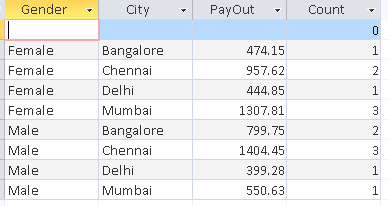SUM () function with group by. The aggregate functions summarize the table data. Once the rows are divided into groups, the aggregate functions are applied in order to return just one value per group.
It is typically used in conjunction with aggregate functions such as SUM or Count to summarize values. In SQL groups are unique combinations of fields. Today I’ll show you the most essential SQL functions that you will use for finding the maximums or the minimums (MAX, MIN) in a data set and to calculate aggregates (SUM, AVG, COUNT). And this is going to be super exciting, as we will still use our.
Group by two columns and display grand. How can I sum a group of sums? The COUNT() function returns the number of rows that matches a specified criteria. The AVG() function returns the average value of a numeric column.
Język SQL jest oparty na matematycznej teorii zbiorów w której (prawie) nie ma przypadków. SQLの複数の行をまとめるサンプルです。 集約関数とgroup by句とhaving句を使用します。 目次. It allows you to collapse a field into its distinct values. This clause is most often used with aggregations to show one value per grouped field or combination of fields.
Consider the following table We can use a group by and aggregates to. Dieser SQL-Befehl wird häufig in Kombination mit den Aggregatfunktionen verwendet. Dane można podsumować wykorzystując kilka tzw. GROUP BY can group by one or more columns. This means to place all the rows with same values of both the columns columnand columnin one group.
A combination of same values (on a column) will be treated as an individual group. Solved: I am trying to sum a metric (AllCost) by three different variables, Age, Study Type, and Year. Aggregate functions are the built-in functions in SQL. They are used for specific operations like to compute the Average of the numbers, Total Count of the records, Total sum of the numbers etc. For each group , you can apply an aggregate function e. Here are some examples of how you can use them.
Sometimes, rather than retrieving individual records, you want to know something about a group of records. Oferuje, więc połączenie możliwości działania na grupach (bo na nich operują agregaty) i na części nie grupowanej – czyli dowolnych kolumnach, w jednym zapytaniu. The following example group the data based on Department. It fetches the data from Employee table and sort the data based on Department Variable. SELECT Department, Sum(Salary) FROM Employee.
FILTER is a modifier used on an aggregate function to limit the values used in an aggregation. I have tried with group by and sum. Get sum of values to another row in a group in SQL. Dans le langage SQL, la fonction d’agrégation SUM() permet de calculer la somme totale d’une colonne contenant des valeurs numériques.
Cette fonction ne fonction que sur des colonnes de types numériques (INT, FLOAT …) et n’additionne pas les valeurs NULL. AS 数量之和 from A group by 类别, 摘要. The SUM command in SQL is used to find the sum of columns that matches the specified criteria. SQL ROW_NUMBER Function Example.

In this example we will show you, How to Select First Row from each SQL Group. First, partition the data by Occupation and assign the rank number using the yearly income. Aggregation combines rows together and performs some operation on their combined values. Very common aggregations are COUNT, SUM , and AVG.
The simplest use of aggregations is to examine an entire table and pull out only the aggregations, with no other columns specified. He goes on to explain the use of adding aggregation functions to display summations, averages, frequencies, and subtotals.
Brak komentarzy:
Prześlij komentarz
Uwaga: tylko uczestnik tego bloga może przesyłać komentarze.